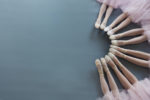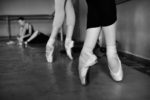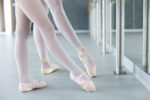Types of Ballet Shoes: How Many Are There?
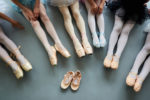
We all know that a good pair of ballet shoes is crucial to every dancer's growth as a performer.
What if you don’t know what type of ballet shoes to buy?
It can get overwhelming really quickly when you’re faced with plenty of choices but don’t have any idea which to choose.
Sometimes, dance instructors have their preferences, making it easy for students to buy their ballet shoes according to what is required.
You should also know that beginners and experienced dancers wear different types.
Confused, yet?
Before we talk about each type of ballet shoes used by toddlers, young and adult beginners as well as professional dancers, let’s go back to the basics.
Do you know what are ballerina shoes called?
What Are Ballet Shoes Called?
Professional dancers wear pointe shoes, the ballet footwear that provides them with sylph-like attributes.
This type of footwear is designed to allow dancers to perform on tiptoes for extended periods.
Before dancers go en pointe, though, they typically start with ballet slippers.
These are lightweight shoes designed for ballet dancing.
In general, male dancers wear ballet slippers throughout the training.
Similarly, female dancers also wear ballet slippers from the start of classes but eventually transition to pointe shoes.
Parts of Ballet Shoes
Now that you know what are ballerina shoes called, let’s talk about their different parts.
It’s good to know the parts that make up your ballet shoes so that it’s easier to determine which part needs repair or is having an issue.
1. Drawstring
The drawstring is the part in a flat ballet shoe used for tightening, ensuring that it stays on your feet.
2. Elastics
Some ballet shoes do not come with a pre-sewn elastic, leaving the dancers to attach it themselves for a more secure fit.
3. Ribbon
The ribbon is usually attached to the shoe.
It is tied around the dancer’s ankle during a performance for added security.
4. Sole
The sole is the bottom part of the shoe, generally made of leather or suede.
Newbies wear full-sole footwear and transfer to split-sole after gaining enough knowledge and training.
5. Box
You will find the box in pointe shoes, covering and supporting the dancer’s toes.
These are layers of materials, often fabric, cardboard, or cotton, that are glued together.
6. Platform
The platform is the flat portion of the box that supports the dancer’s entire body weight while performing en pointe.
7. Vamp
The vamp encloses the box and platform in a pointe shoe.
It is the entire length of the box starting from the platform to the throat.
8. Insole or Shank
The shank functions as the stiff sole supporting the feet en pointe.
It is commonly made of cardboard, leather, or plastic.
9. Throat
The throat is the shoe’s opening.
10. Wings
The wings are the side portions of the box.
11. Cover
Once all the parts are assembled, it is carefully wrapped with either of the three materials for ballet shoes.
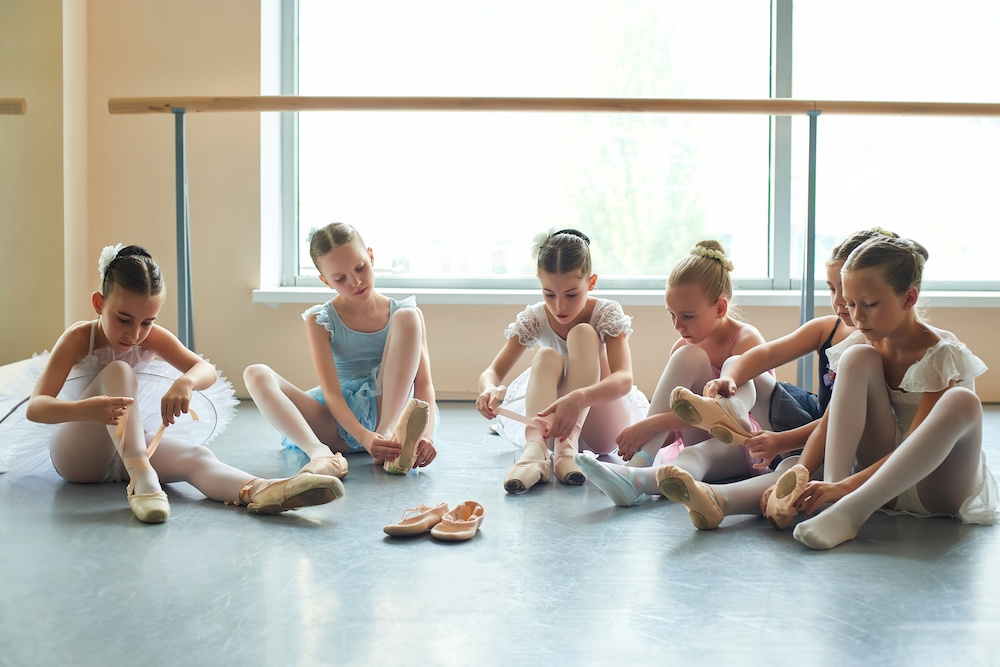
How Many Types of Ballet Shoes Are There?
Ballet shoes come in different styles appropriate for each dancer’s level of training and experience.
Knowing each ballet shoe type allows you to choose the perfect pair that’s suitable for your needs.
Full-Sole
A full-sole ballet shoe is the perfect choice for new dancers, as it provides the support and stability they need.
In fact, even those with a little more experience also like using this shoe type.
It has a full leather sole that runs the length of the ballet shoe.
Most dance teachers suggest this type, especially for girls between ages four and seven, to help build foot strength.
Full-sole ballet shoes offer sufficient traction and resistance needed by these little dancers’ tiny feet.
It’s a lightweight and flexible footwear that is comfortable to the feet and allows the dancers to manipulate the dance floor with ease.
Typically used during the early parts of the dance training, full-sole shoes provide an excellent balance, developing strength for the dancer’s instep.
A full-sole ballet shoe offers appropriate support for the arch, forcing the dancer’s foot and muscle to work.
This movement teaches them the right skill while helping to maintain muscle memory as preparation for advanced training.
Full-sole shoes such as the Capezio ballet shoes are usually made of leather material.
Split-Sole
A spit-sole type of ballet shoes has different heel and toe pads made of rough materials for traction, which divide it into two parts, hence the name.
The bottom of each sole has soft materials to protect the feet since the shoe’s center lacks enough support.
This design makes the shoe flexible, eliminating the risk of getting injured.
This lack of support also allows the dancers to flex and point their feet, emphasizing the arch’s curve.
Students who have gained more experience and training are more likely to use this shoe type.
Split-sole ballet shoes allow the dancers to perform cleaner footwork and techniques with ease, which are crucial during competitions and practical examinations.
Dancers who use this type of shoes have more balance and confidence as they try to develop their spins and movement.
Usually made of canvas, it is the perfect pair for intermediate and advanced dancers who have already completed several ballet training years.
Demi-Pointe
These ballet shoes do not come with a shank but have a leather outsole instead.
This design provides more resistance, requiring the dancer’s feet to work harder.
There are some arguments among instructors if this type of ballet shoes is even necessary for their students to use.
Some allow their students to wear this to transition to going en pointe to strengthen their muscles.
Others do not recommend this shoe type for students who do not have sufficient training and experience yet.
Inexperienced dancers might not know the proper techniques to use the right forefoot muscles when executing foot works and positioning.
Still, most instructors agree that wearing demi-pointe ballet shoes dramatically helps build the right muscles, as long as the dancer knows which to use and how to do it properly.
Pointe Shoes
Pointe shoes come with a shank, offering support when dancing en pointe.
Only experienced dancers who have completed several years of ballet training get to wear this ballet shoe type.
These shoes provide sufficient support for the dancer’s feet and ankle as they perform all their en pointe choreographies.
Professional ballerinas appear weightless and floating when they perform wearing these specialty ballet shoes.
Pointe shoes make it easier for ballerinas to dance on tiptoes.
Don’t be fooled by the dainty appearance of this exceptional footwear, though.
It has a rigid toe box made of thick packs of layered cardboard or fabric and then hardened with glue.
The sturdy but comfortable construction of this custom-made ballet shoe supports the entire body weight.
What Materials Should I Choose?
Ballet shoes are made of different materials, which are canvas, leather, and satin.
Ballet dancers may look fragile while performing, but they possess exceptional endurance and strength.
Ballet shoes’ material is one factor that can impact a dancer’s performance.
For this reason, ballerinas make it their business to pay attention to their footwear’s construction.
Let’s check the different materials commonly used for ballet shoes.
Canvas
Ballet shoes made from canvas are easy to clean and maintain.
You can toss it in the washing machine after every use, ensuring clean footwear each time.
These lightweight canvas shoes nicely hug the feet, emphasizing the lines and shape, and are perfect for beginners.
However, these shoes do not last long and can easily show wear and tear through constant use.
Leather
Leather ballet shoes are more durable than canvas.
It is a hard-wearing material that helps in strengthening the dancer’s feet and ankle.
This sturdy material has a higher price-point than canvas but allows you to use the ballet shoes longer, saving you money in the long run.
It also needs sufficient time for breaking in before conforming completely to your feet.
Satin
This attractive-looking fabric is the most delicate among the three materials.
Therefore, dancers only use satin ballet shoes on special occasions.
Traditionally, satin ballet shoes come in light-pink tones.
Today, they are now available in several colors, depending on the performance’s required theme.
How To Clean Your Ballet Shoes
Ballet performances are highly technical—all the dancers involved in the production endeavor to perfect everything, including their dance attire.
Ballet shoes are the most vital accessory in any performance.
It is the determining factor in a dancer’s footwork execution.
As a dancer, you must ensure that your ballet shoes are in perfect condition and must look flawless at all times.
Ballet shoes are made from three different materials, and each one requires specific cleaning methods.
Canvas ballet shoes are machine-washable, making them easy to clean.
Spot-cleaning is perfect for leather ones, while you can use baking soda for satin.
Here are some guidelines on how to properly clean each shoe material.
Canvas
As mentioned, canvas shoes are machine-washable.
Using a mild detergent, run it on a delicate cycle but never put it in the dryer.
Spot-cleaning with either a detergent or dish soap is perfect for small stains.
Leather
Leather shoes are not resistant to dirt.
Spot-cleaning is perfect for superficial marks by applying a damp cloth to the surface.
You can apply a mild detergent or a dish soap to the spot for deep stains, then wipe off the traces immediately with a clean cloth.
Satin
The beauty of the satin fabric is unbeatable. However, cleaning and maintaining its shine are complicated.
You can conceal scuff marks as a precautionary measure by dabbing calamine lotion or foundation in the same tone.
You can also mix a small amount of water and baking soda and apply it on the spot in a circular motion using a toothbrush or a cloth.
Leave it overnight and then wipe it off with a damp cloth, ensuring that every trace of the solution is removed.
Different Types of Ballet Shoes
Now that you know the different types of ballet shoes, it would be easier to find the right pair that will fit you perfectly.
In short, look for the one with the most comfortable feel.
The shoes play a significant role in how the dancers perform while being safe.
Check out some of our ballet shoe reviews and find the best that suits your needs.


